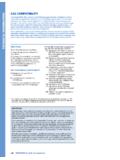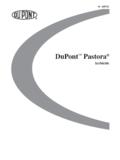Transcription of Pharma Solutions Chemistry of METHOCEL™ - DuPont
1 Nutrition & Biosciences Pharma Solutions Chemistry of METHOCEL . Cellulose Ethers - A technical Review Nutrition & Biosciences Chemistry of METHOCEL Cellulose Ethers Regulated Uses METHOCEL cellulose ether products are available in two basic types: methylcellulose and hydroxypropyl Pharmaceuticals methylcellulose. Premium grades of METHOCEL products meet the Both types of METHOCEL have the polymeric backbone specifications of the United States Pharmacopoeia (USP. of cellulose, a natural carbohydrate that contains a basic XXIII), European Pharmacopoeia (EP) and Japanese repeating structure of anhydroglucose units. Pharmacopoeia (JP) and are listed as methylcellulose and hypromellose1. In addition, methylcellulose (METHOCEL . A products) is Generally Recognized As Safe (GRAS) by the Food and Drug Administration. To support new drug applications in the United States, drug master files (DMFs) for these products are on file at the Bureau of Drugs of the Food and Drug Administration.
2 Comparison of METHOCEL Grades for Pharmaceutical Applications Comparison of METHOCEL Grades for Pharmaceutical Applications METHOCEL . K3 LV K100 LV K4M K15M K100M E3 LV E5 LV E6 LV E15 LV E50 LV E4M E10M VLV A15 LV A4C A15C A4M. Premium Products: Viscosity 2,663- 13,275- 75,000- 2,663- 9,525- 1,298- 2,663- 80-120 12-18 40-60 12-18 320-480. ( 2% in water at 20C) 4,970 24,780 140,000 4,970 17,780 2,422 4,970. Methoxyl substitution N/A. If CR designation, N/A N/A N/A N/A N/A N/A N/A N/A N/A N/A N/A. methoxyl substitution Hydroxypropoxyl N/A N/A N/A N/A N/A. substitution If CR designation, hydroxypropoxyl N/A N/A N/A N/A N/A N/A N/A N/A N/A N/A N/A. substitution Loss on Drying (weight %) Max Max Max Max Max Max Max Max Max Max Max Max Max Max Max Max Max If CR designation, Particle size, N/A N/A N/A N/A N/A N/A N/A N/A N/A N/A N/A. % thru 40 mesh If CR designation, Particle size, N/A N/A N/A N/A N/A N/A N/A N/A N/A N/A N/A. % thru 100 mesh If CR designation, Particle size, N/A N/A N/A N/A N/A N/A N/A N/A N/A N/A N/A.
3 % thru 230 mesh (These are typical properties, not to be construed as specifications). 1 The former official monograph name of hypromellose was hydroxypropyl methylcellulose or HPMC . 2. How to Prepare Aqueous Solutions of This time delay of hydration or viscosity build is a METHOCEL Cellullose Ethers function of the level of surface treatment as well as temperature, pH of the system, and concentration of METHOCEL cellulose ether products are carbohydrate the METHOCEL product. Normally, the concentration polymers which dissolve in cold water (and in some of METHOCEL in the system does not become a factor instances in certain organic solvents) by swelling and until the concentration exceeds 5% by weight (relative to subsequent hydration. There is no sharp solubility limit water in the system). At higher concentrations, the time such as occurs in the dissolution of ionizing salts. The of hydration (referred to as delay time) is reduced.
4 The concentration of METHOCEL in solution is usually limited delay time is generally reduced as temperature is raised. by the viscosity that a manufacturer is equipped to handle. In many cases it is desirable to trigger viscosity build It also depends on the viscosity and chemical type of immediately following dispersion. Aqueous slurries can METHOCEL product used. Solutions of low-viscosity be held for 45 minutes and still remain usable in neutral products can be made at 10% to 15% concentration while systems. A trigger can be conveniently initiated by adding high-viscosity products have a normal limit at 2% to 3% a small amount of a base, such as ammonium hydroxide, concentration. sodium bicarbonate, etc. If METHOCEL is dispersed in The form of METHOCEL cellulose ether product chosen neutral water (pH approximately 7), there is adequate time (powder, surface-treated powder or granules) influences for thorough dispersion. Addition of base to raise the pH to the techniques used to make Solutions .
5 Surface-treated approximately 9 causes the hydration to be completed in and granular products can be added directly to aqueous just a few minutes. systems. They disperse readily with mild agitation For best results and to achieve maximum hydration, and dissolve (build viscosity) gradually under neutral surface-treated powders should be added with good conditions. The dissolution rate of surface-treated products agitation to a neutral pH system. The system should be can be increased by adjusting to an alkaline pH after agitated thoroughly for a few minutes, followed by an dispersing the powder in water. Although untreated adjustment of pH to to with continued agitation, METHOCEL powders are soluble in cold water, they until full viscosity is reached (usually 10 to 30 minutes). must first be thoroughly dispersed in the water to prevent Once the pH has been shifted to the alkaline side (pH lumping. to ), allowing full and rapid solubilization of the surface- Working with Surface-Treated Dispersible Powders treated product, Solutions will be stable over the pH range of 3 to 11.
6 In many applications, the combination of easy dispersion in cold water and rapid hydration (viscosity build) is The addition of a slurry to an alkaline pigment grind desirable. or filler dispersion, or the addition of a slurry to a basic pigment-latex formulation, provides rapid solubilization Surface-treated METHOCEL powders are chemically and uniform viscosity development. The addition of dry, treated so that they become temporarily insoluble in cold alkaline pigments or fillers to a slurry on high-speed water. This allows the METHOCEL product to be added or low-speed mixing equipment also results in rapid to a formulation and dispersed at relatively low shear solubilization and viscosity development. without any significant initial increase in viscosity. 3. Nutrition & Biosciences Working With Untreated Powders Dispersion Techniques Although METHOCEL powders are soluble in cold water, 1. Add the surface-treated METHOCEL . they must first be thoroughly dispersed in the water to powder to the water.
7 Begin agitation. prevent lumping. In some applications, dispersion can be accomplished at ambient temperatures or in cold water 2. Continue agitation and add sufficient by using an eductor funnel or high-shear mixer. However, ammonium hydroxide, sodium bicarbonate, if untreated powders are added directly to cold water or other alkaline material ( , pigment without sufficient agitation, a lumpy solution may result. grind) to the dispersion to obtain a pH of Lumping results from incomplete wetting of the individual to This will result in rapid viscosity powder particles. Only part of the powder dissolves, and development. Continue agitation until a gelatinous membrane shields the remaining powder sufficient hydration has been achieved. from complete hydration. Several dispersion techniques are commonly used and are described below. Each has advantages in certain applications. 1. Add the METHOCELTM cellulose ether to the non-solvent. A ratio of 5-8 parts non-solvent Dispersion in Hot Water to 1 part METHOCEL is recommended to Often called the hot/cold technique, this method takes obtain a liquid slurry.
8 Advantage of the insolubility of METHOCEL cellulose ethers in hot water. The powder is first dispersed by mixing 2. Agitate the mixture and METHOCEL . thoroughly with 1/5 to 1/3 of the total required volume of powder until the particles of METHOCEL . water that has been heated to above 90 C (194 F). Mixing cellulose ether are evenly dispersed. continues until all particles are thoroughly wetted. 3. The dispersion of METHOCEL in a For complete solubilization, the remainder of the water is nonsolvent medium may be added to cold then added as cold water or ice to lower the temperature water, or cold water may be added to the of the dispersion. Once the dispersion reaches the dispersion. temperature at which that particular METHOCEL product becomes water soluble, the powder begins to hydrate and 4. Continue mixing until the METHOCEL . viscosity increases. powder is completely hydrated and the In some applications, it may be desirable to heat the entire solution is smooth.
9 You can now add the volume of water, disperse the METHOCEL powder, and remaining ingredients in your formulation. then cool the mixture while agitating until hydration is complete. It is very important, however, to have adequate cooling after wetting with hot water to ensure complete hydration and viscosity development. Dispersion in Concentrated Salt Solutions Both untreated and surface-treated METHOCEL cellulose ethers can be dispersed in concentrated salt Solutions . Dissolution occurs when the brine is diluted with cold water. Dispersion by Dry-Blending Dry-blending involves mixing METHOCEL powder with other dry ingredients before adding the water component. Dry-blending separates the particles of METHOCEL . cellulose ethers to allow thorough wet-out and complete hydration when water is added. The minimum ratio of other dry, powdered ingredients to METHOCEL powder varies from 7:1 to 3:1. 4. How to Prepare Solutions of METHOCEL . Celulose Ethers in Non-Aqueous Solvents and Non-solvent Media Solvents The solubility of METHOCEL cellulose ethers in non- aqueous media varies according to the nature and quantity of substituent groups on the anhydroglucose chain.
10 When using a water-miscible, organic solvent, such as an alcohol or glycol, use a ratio of at least 5 to 8 parts solvent to 1 part METHOCEL . Dispersion in Non-solvent Media Untreated METHOCEL cellulose ethers may also be dispersed in non-solvent media such as vegetable oil, propylene glycol, polyethylene glycol, glycerine, corn syrup, and high-fructose corn syrup. A ratio of 5 to 8 parts nonsolvent to 1 part METHOCEL is recommended to obtain a fluid slurry. The dispersion of METHOCEL in a non-solvent medium may then be added to cold water, or the cold water may be added to the dispersion. 5. Nutrition & Biosciences Equilibrium Moisture Content Versus Percent Relative Properties of METHOCEL Celulose Ethers in Equilibrium EquilibriumMoisture Content Moisture Content Humidity (25 C). Versus Versus Percent Percent Relative Relative Humidity(25 C). Humidity (25 C). Powder Form METHOCEL cellulose ether products are white to slightly 40. off-white powders which are essentially odorless and 40.







